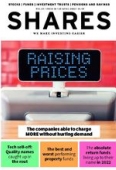Archived article
Please note that tax, investment, pension and ISA rules can change and the information and any views contained in this article may now be inaccurate.
Can consumer-facing firms beat the big squeeze?

Soft drinks giant Coca-Cola’s (KO:NYSE) first quarter results (25 Apr) topped Wall Street expectations as consumers gulped down more of its namesake brand as well as Powerade and Costa Coffee as the world continued to reopen.
But the beat was also driven by higher prices, with Coca-Cola’s sales performance including 7% growth in price and product mix.
Coca-Cola is well known for its brand strength which should enable it to hike the cost of a can without people losing appetite for the product.
However, rising input costs are adding to margin pressures for consumer-facing firms across the board.
And many are, like Coca-Cola, having to raise prices in order to mitigate the impact. Recent forecast-busting third quarter earnings from Procter & Gamble (PG:NYSE) were boosted by price hikes to offset inflation, while food giant Nestle (NESN:SWX) raised prices by 5.2% in the first three months of 2022 and has warned rising costs will necessitate further increases over the course of the year.
Associated British Foods’ (ABF) budget clothing chain Primark is also set to implement ‘selective price increases across some of the autumn/winter stock’ to mitigate soaring costs, though ABF stressed it is ‘committed to ensuring our price leadership and everyday affordability, especially in this environment of greater economic uncertainty’.
Consumer facing firms, particularly those known for bargain prices, have to strike a balance between protecting margins and ensuring cash-strapped customers can afford their products. And ABF appears to be striking that balance, acknowledging that margins in the second half of its financial year will be lower than anticipated.
In the UK, shopper confidence has plummeted to record lows according to the latest Shopper Confidence Index from IGD Shoppervista, with March’s Index score falling from -18 in February to -23.
The latest consumer confidence survey from GfK showed the overall index hitting a multi-year low of -38 points, while the March retail sales figures from the ONS (office for National Statistics) showed retail sales volumes falling by 1.4% between February and March.
Morgan Stanley points to three reasons why the months ahead could get more challenging for consumer staples in particular.
Input costs are expected to stay elevated for longer, income constrained and emerging market consumers face ‘amplified headwinds’ in the form of rising food and energy costs, while downtrading risk is rising, particularly for food and home care companies.
Investors should monitor earnings updates to see which consumer-facing companies have been able to hike prices successfully without alienating their customers.
Toothpaste titan Colgate-Palmolive (CL:NYSE) is set to issue figures on 29 April, Starbucks (SBUX:NASDAQ) (3 May) and Walmart (WMT:NYSE) to follow (17 May).
Important information:
These articles are provided by Shares magazine which is published by AJ Bell Media, a part of AJ Bell. Shares is not written by AJ Bell.
Shares is provided for your general information and use and is not a personal recommendation to invest. It is not intended to be relied upon by you in making or not making any investment decisions. The investments referred to in these articles will not be suitable for all investors. If in doubt please seek appropriate independent financial advice.
Investors acting on the information in these articles do so at their own risk and AJ Bell Media and its staff do not accept liability for losses suffered by investors as a result of their investment decisions.
Issue contents
Feature
- Great buying opportunities from the big tech rout
- The companies able to charge more without hurting demand
- Explaining the poison pill defence which could have derailed Musk’s Twitter bid
- How big property funds have performed and the different ways to invest
- Emerging markets: Views from the experts
- The best and worst first quarter performers in emerging markets
- Why Unilever has a 10.5% stake in this small cap drug developer
Great Ideas
- Strong reasons to buy Strix, a global leader in niche market
- Loungers maintains fast growth despite facing consumer headwinds
- Brookfield and Homeserve in talks as broker says shares could be worth £15
- Asia Dragon Trust goes shopping for stocks amid market sell-off
- Smartly-timed sale and share buyback reveal Spectris’ hidden value
- Why B&M remains a great way to beat the squeeze
News
- Novacyt faces £134.6 million NHS legal claim
- Can consumer-facing firms beat the big squeeze?
- Growth stocks continue to struggle as we reveal stocks at 52-week highs and lows
- Shares in mining companies hurt by Chinese lockdowns and operational issues
- Why language services group RWS could be the latest private equity victim

 magazine
magazine








